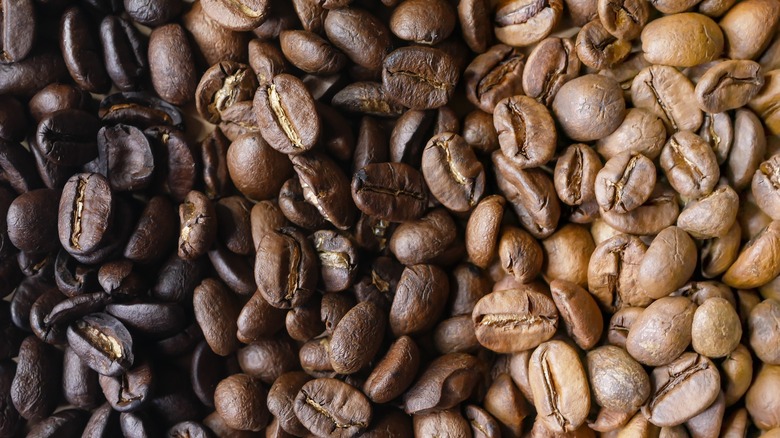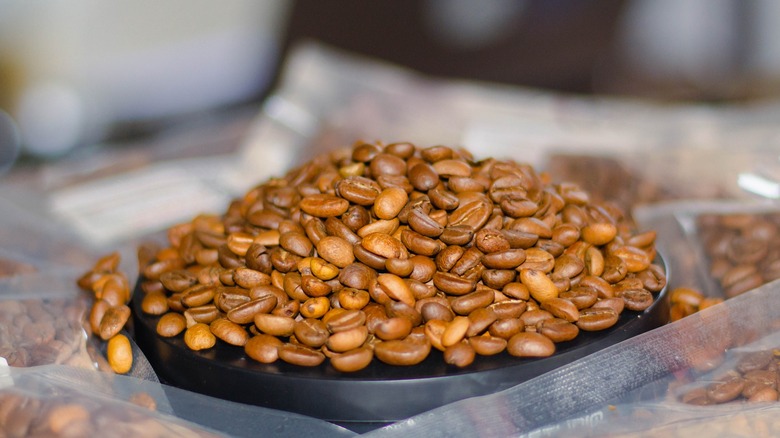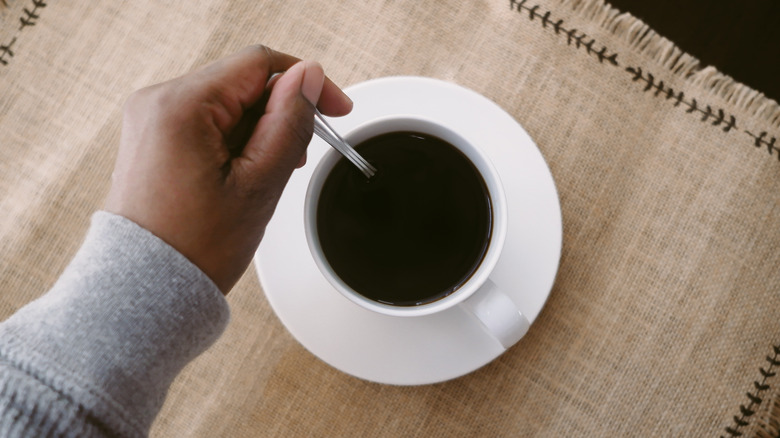What's The Actual Difference Between Light And Dark Roast Coffee?
To say that coffee is popular is an understatement — as of 2024, over one billion people worldwide claim to drink at least one cup of coffee every day, per BusinessDasher. But not everyone is enjoying the exact same style as their neighbor. From smoky French roast to the sweeter white coffee, there are quite a few types of beans to choose from before you enjoy your morning cup of caffeinated goodness.
Two of the most popular types of coffee are light roast and dark roast. Before coffee beans are ground and transformed into a delicious cup of joe, most blends are roasted in order to bring out all the complex flavors and aromas. Light and dark roasted beans usually look similar, so it can be difficult to decipher which one is which — until you take a sip, that is. Ultimately, the biggest distinction comes from how long the coffee beans were roasted, resulting in a very different taste and mouthfeel, even if the exact cultivar of beans is the same.
Serious at-home coffee aficionados might decide to roast their own coffee beans at home, while other coffee lovers will opt for snagging a prepared bag from their grocery store or local coffee shop. No matter where you get your coffee, here are a few key differences to help you decide if you'll like a dark roast better, or a walk on the lighter side instead.
Light roast coffee beans are more caffeinated than dark roast
Light roast coffee gets its name because it is roasted for a relatively short amount of time, resulting in lighter-colored beans. The beans are also roasted at a lower temperature than with a dark roast, and are removed from the heat once they reach between 385 and 410 degrees Fahrenheit. Coffee roasters usually listen for the beans to "crack," a sound which indicates they have reached the ideal temperature for a light roast.
Lightly-roasted beans dry out less due to the shorter cook time, which results in more density in each bean. Less time under the heat also preserves more of their caffeine content, allowing for more of a buzz in your mug. While this roasting style results in a slightly thinner drink than with a dark roast, it makes up for it with that signature boost of energy that you might look for in your caffeinated beverage.
These roasts also offer a more subtle yet complex flavoring due to their short roasting time, and might come across as slightly sweeter when compared to dark roast coffee. Most often, you will find notes of florals, nuts, and even fruit swirling around in a light roast brew. This style of coffee pairs beautifully with lighter flavors and syrups like vanilla, coconut, and lavender.
Dark roast coffee beans offer a fuller flavor profile
If you are looking for a full-bodied, bitter drink that practically hits you in the face with that signature coffee flavor, a dark roast is the one for you. Dark-roasted beans must reach a temperature between 430 degrees and 440 degrees Fahrenheit. After the first crack happens, a second crack usually signifies that the coffee has reached the right temperature for a dark roast.
Dark roast coffee offers less density and caffeine than lighter roasts, because most of its moisture is removed during the lengthy heating process. Dark roast coffees usually appear almost black in color, and offer a distinct nuttiness and smokiness that a light roast lacks. The bold taste of this type of coffee is often combined with stronger flavorings like caramel, hazelnut, and cinnamon, in the form of various sweeteners and syrups. The robust taste of dark roast coffee makes for delicious cookies, too.
When you are deciding between a dark roast and a light roast, consider your current needs. If you are looking for something light and sweet that will really pick you up first thing in the morning, a light roast may be the way to go. If it is later in the day and you are hoping to savor the richness of your coffee without a major caffeine boost — or you simply prefer a bolder flavor — we recommend a dark roast.



